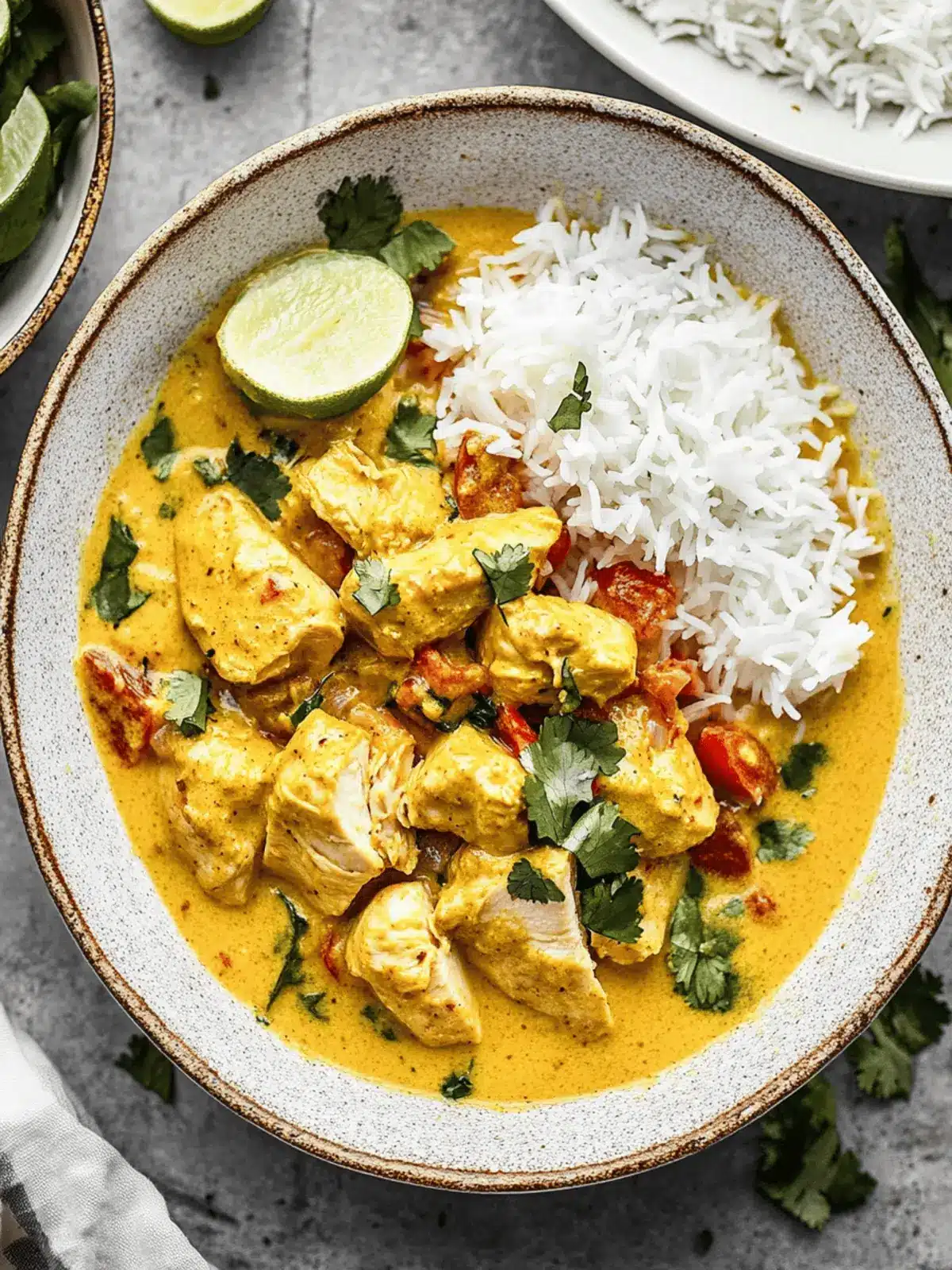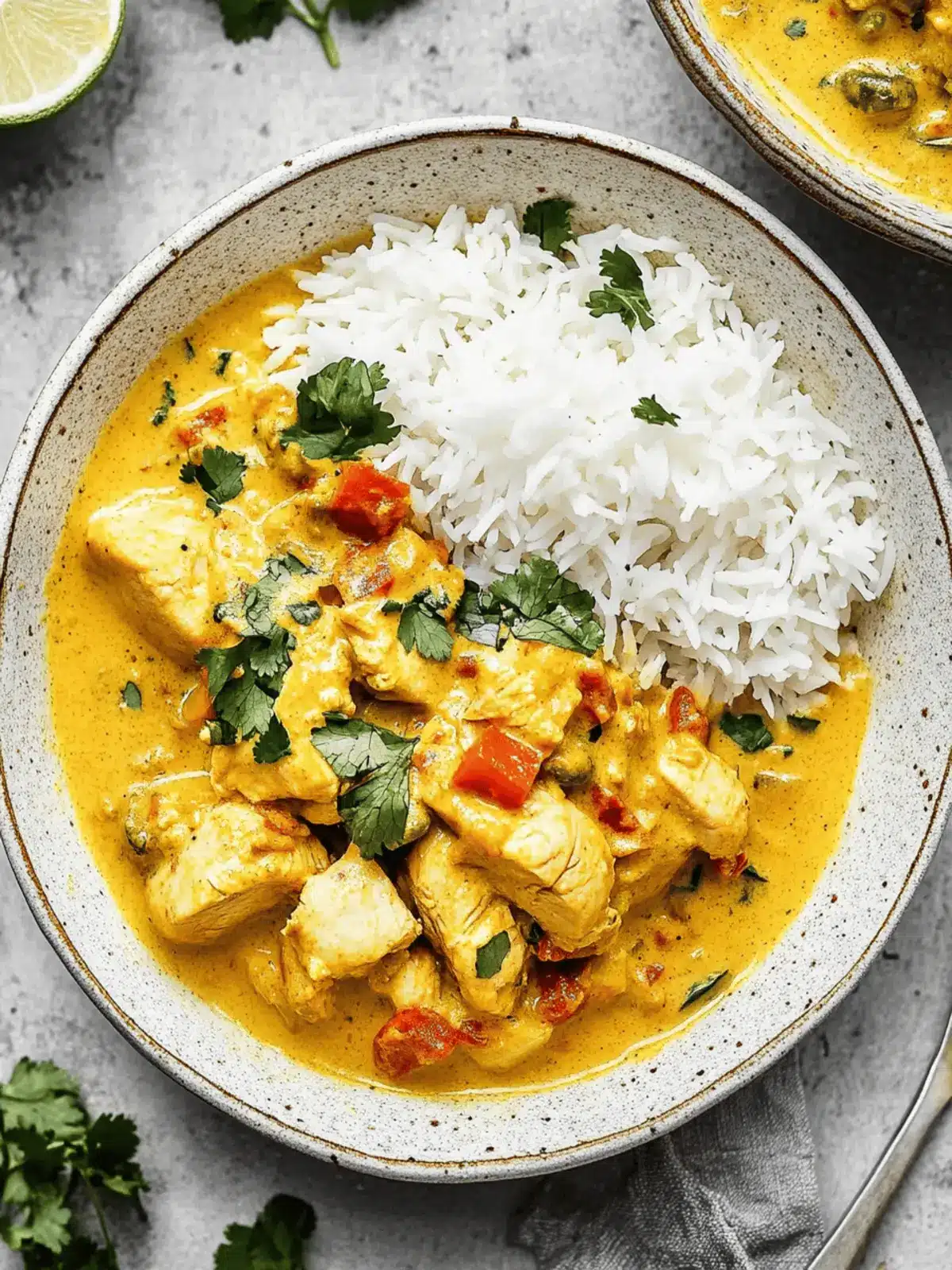There’s nothing quite like the comforting embrace of a warm, flavorful dish after a long day, and that’s exactly what this Easy One-Pan Coconut Curry Chicken brings to your table. The moment you start sautéing onions and garlic, the aroma fills your kitchen, igniting a sense of anticipation. Inspired by the vibrant cuisines of Thailand and India, this recipe is a delightful symphony of creamy coconut milk and aromatic spices, bringing a world of flavor into just 30 minutes.
I love how it’s versatile—so whether you have chicken on hand, want to opt for tofu, or even some succulent shrimp, you can tailor it to suit your preferences. The best part? Cleanup is a breeze, allowing you to savor every bite without the hassle. This gluten-free gem delivers a hearty dose of protein, making it a satisfying choice for dinner that doesn’t skimp on flavor. Let’s dive into how you can whip up this nourishing and delicious meal in your own kitchen!
Why is Coconut Curry Chicken Breast a Must-Try?
Unmatched Flavors: The rich, creamy coconut milk combined with aromatic spices creates an unforgettable taste sensation that transports you straight to the streets of India and Thailand.
Quick to Prepare: Ready in just 30 minutes, this one-pan wonder is perfect for busy weeknights when time is of the essence.
Customizable Goodness: Whether you prefer chicken, shrimp, or tofu, this recipe adapts effortlessly to suit your protein cravings or dietary needs.
Easy Cleanup: With only one pan required, you can enjoy a delicious meal without the post-dinner mess—just savor and relax.
Healthy Comfort: Packed with protein and gluten-free ingredients, it’s a deliciously nourishing option that satisfies without guilt.
Embrace this delightful dish today and discover why it’s a family favorite!
Coconut Curry Chicken Breast Ingredients
For the Base
- Extra-virgin olive oil – Provides healthy fats for cooking; substitute with coconut oil for extra coconut flavor.
- Medium yellow onion – Offers sweetness and depth to the curry; shallots can be used as an alternative.
- Red bell pepper – Adds sweetness and vibrant color; green bell pepper is a viable substitute.
- Garlic cloves – Essential for aromatic flavor; use garlic powder in a pinch, though fresh is recommended.
- Fresh ginger – Adds warmth and zest; ground ginger (1 tsp) can substitute if fresh is unavailable.
For the Protein
- Boneless skinless chicken breasts – The main protein source providing tender texture; chicken thighs or firm tofu are great alternatives.
For the Spice Blend
- Curry powder – The primary seasoning that contributes to the curry flavor profile; additional spices can be adjusted based on your preference.
- Garam masala – Enhances the dish’s warmth with its blend of spices; similar warm spices can be used (e.g., allspice).
- Ground coriander – Adds brightness and flavor complexity; mustard or cumin make effective substitutes.
- Kosher salt and ground black pepper – Elevate the overall flavor; adjust to your personal taste.
For the Sauce
- Full-fat coconut milk – Creates a creamy sauce; can be replaced with light coconut milk or dairy alternatives for a lower-fat option.
- Lime juice – Adds brightness and acidity to balance flavors; lemon juice can be used if lime is unavailable.
For Serving
- Cooked rice – Serves as a base to soak up the sauce; cauliflower rice is a great low-carb alternative.
- Fresh cilantro – Offers a fresh garnish and finish; substitute with parsley if cilantro isn’t your favorite.
Discover how these simple yet vital ingredients come together to create the unforgettable Coconut Curry Chicken Breast experience that your family will love!
How to Make Coconut Curry Chicken Breast
-
Sauté Vegetables: Heat olive oil in a large sauté pan over medium heat. Add diced onion and bell pepper, and sauté for 2-3 minutes until they start to soften. Incorporate minced garlic and ginger, stirring for an additional minute until fragrant.
-
Add Chicken and Seasoning: Add cubed chicken breasts to the pan, seasoning generously with curry powder, garam masala, ground coriander, kosher salt, and black pepper. Cook for 5-7 minutes, stirring frequently, until the chicken is browned and cooked through.
-
Make the Sauce: Pour in the full-fat coconut milk and lime juice; let the mixture simmer for about 5 minutes. Stir occasionally to meld the flavors and create a creamy sauce.
-
Serve: Spoon rice into bowls, top it with the coconut curry chicken, and garnish with freshly chopped cilantro for a burst of color and flavor.
Optional: Serve with warm naan for a delightful accompaniment.
Exact quantities are listed in the recipe card below.

What to Serve with Coconut Curry Chicken?
Elevate your dinner with delightful pairings that complement the vibrant flavors and creamy texture of this comforting dish.
- Fluffy Jasmine Rice: This aromatic rice soaks up the delicious coconut curry sauce perfectly, creating a harmonious balance of textures.
- Warm Naan Bread: Perfect for dipping into the rich curry sauce, naan adds a delightful chewiness that enhances your dining experience.
- Steamed Broccoli: Crisp broccoli adds a fresh crunch and a nutritional boost, bringing brightness to your plate.
- Cucumber Salad: The coolness of a cucumber salad refreshes the palate, balancing the warmth of the curry with a zesty crunch.
- Mango Chutney: Sweet and tangy mango chutney brings a burst of flavor that pairs beautifully with the coconut notes.
- Chilled Coconut Water: This thirst-quenching drink echoes the flavors in the dish and keeps you refreshed throughout your meal.
- Lemon Sorbet: A light and refreshing dessert that cleanses the palate after the rich flavors of the curry, leaving you satisfied yet eager for more.
- Roasted Cauliflower: The nutty flavor of roasted cauliflower complements the dish while adding a unique texture to your meal.
- Spicy Green Beans: Add a spicy crunch to your plate, creating a delightful contrast that enhances the overall dining experience.
Expert Tips for Coconut Curry Chicken
-
Proper Oil Temperature: Heat your olive oil adequately before adding the vegetables; this helps them sauté rather than steam, enhancing flavor.
-
Chicken Cooking Time: Ensure the cubed chicken is cooked through by checking that the internal temperature reaches 165°F; this prevents any undercooked bites.
-
Creamy Sauce Mastery: For an extra creamy sauce, let the coconut milk simmer gently—too high heat can cause it to separate.
-
Vegetable Variations: Don’t hesitate to toss in any leftover veggies you have; this coconut curry chicken breast recipe is forgiving and welcoming to additions!
-
Spice Level Adjustment: If you prefer a milder flavor, start with less curry powder and gradually add more until it reaches your desired heat level.
-
Storage Tips: Store any leftover curry in an airtight container in the fridge for up to 5 days; serve it over fresh rice for a quick meal!
How to Store and Freeze Coconut Curry Chicken
- Fridge: Store leftover Coconut Curry Chicken in an airtight container for up to 4-5 days. If possible, keep the rice separate to maintain its texture.
- Freezer: For longer preservation, freeze the curry in airtight containers for up to 3 months. Thaw in the fridge before reheating for best results.
- Reheating: To reheat, warm the curry on the stove over medium heat, adding a splash of coconut milk or water to maintain creaminess, stirring until heated through.
- Airtight Storage: Ensure containers are airtight to prevent freezer burn or spoilage, keeping your meal enjoyable for later craving.
Coconut Curry Chicken Breast Variations
Customize this dish to suit your taste buds and pantry items, allowing you to create a meal uniquely yours!
-
Protein Swap: Substitute chicken with shrimp, pork, or firm tofu for varied textures and flavors. Each protein brings its own flair to the curry experience, ensuring enjoyment with every bite.
-
Veggie Boost: Add vegetables like zucchini, carrots, or snap peas for added nutrition and color. The sweet crunch of fresh veggies complements the creamy curry beautifully.
-
Spice It Up: Increase the heat by adding fresh chilies or choose a spicier curry powder. Adjusting the spice level allows you to cater to your family’s preferences and kick the flavor up a notch.
-
Coconut Alternative: Use light coconut milk or almond milk for a lighter version while still maintaining a creamy texture. This variation can help reduce calories without sacrificing flavor.
-
Citrus Zing: Swap lime juice for lemon juice to bring a different citrus twist to your curry. The brightness of lemon can create a refreshing contrast with the warm spices.
-
Herb Substitution: If cilantro isn’t your favorite, parsley or basil can be used for a fresh finish. Each herb adds a unique nuance that can refresh the overall flavor profile of the dish.
-
Rice Alternatives: Serve over cauliflower rice or quinoa for a low-carb option that’s just as satisfying. These alternatives soak up the delicious curry sauce while maintaining a hearty base.
-
Nutty Flavor: Incorporate a spoonful of peanut butter or almond butter into the sauce for a nutty richness that pairs beautifully with coconut. This unexpected twist can take the dish to new levels of deliciousness!
Make Ahead Options
These Coconut Curry Chicken Breast are perfect for meal prep enthusiasts! You can chop all your vegetables and marinate the cubed chicken up to 24 hours in advance; just refrigerate them in airtight containers to maintain freshness. Additionally, you can prepare the entire curry sauce and store it separately for up to 3 days. When you’re ready to enjoy your meal, simply heat the veggies and chicken in a sauté pan, add your prepped sauce, and let it simmer for a few minutes until heated through. This way, you’ll have a delicious, home-cooked meal ready to serve with minimal effort on busy weeknights!

Coconut Curry Chicken Breast Recipe FAQs
How do I select the right ingredients for my Coconut Curry Chicken Breast?
Absolutely! When choosing ingredients, look for firm, bright-colored vegetables, especially for your red bell pepper and onion, as they indicate freshness. Fresh ginger should be firmer with a smooth skin, and coconut milk should be full-fat for the creamiest texture. If using chicken, select boneless skinless breast pieces that are pale pink without any dark spots.
How should I store leftover Coconut Curry Chicken Breast?
You can store your leftover Coconut Curry Chicken in an airtight container in the fridge for up to 4-5 days. To keep the rice from becoming mushy, I recommend storing it separately. This way, you can easily heat up the pieces you want without sacrificing texture.
Can I freeze Coconut Curry Chicken Breast for later?
Very! For freezing, allow the curry to cool completely, then transfer it into airtight containers or freezer bags. It will keep well for up to 3 months. When you’re ready to enjoy, thaw it in the fridge overnight and reheat gently on the stove, adding a splash of water or coconut milk to restore its creamy consistency.
What should I do if my curry is too thick?
If your Coconut Curry Chicken Breast turns out too thick, don’t worry! Simply add a bit of warm water or extra coconut milk, stirring gradually until you reach your desired consistency. This should help keep the flavor rich while ensuring it’s not overly dense.
Are there any dietary considerations for this recipe?
Yes! This Coconut Curry Chicken is gluten-free, making it a suitable option for those with gluten sensitivities. For those with dairy allergies, you can easily substitute the full-fat coconut milk with any dairy-free alternative you prefer. If cooking for pets, avoid adding ingredients like onions or garlic, which can be harmful to them.
What if I want extra vegetables in my Coconut Curry Chicken Breast?
Absolutely! You can add any vegetables you like. Spinach, broccoli, or snap peas are all fantastic options. Just add them after you’ve browned the chicken, letting them sauté until they’re bright and tender—this will give your dish both nutritional benefits and a beautiful burst of color.

Savory Coconut Curry Chicken Breast in One Pan Bliss
Ingredients
Equipment
Method
- Heat olive oil in a large sauté pan over medium heat. Add diced onion and bell pepper, and sauté for 2-3 minutes until they start to soften.
- Incorporate minced garlic and ginger, stirring for an additional minute until fragrant.
- Add cubed chicken breasts to the pan, seasoning generously with curry powder, garam masala, ground coriander, kosher salt, and black pepper. Cook for 5-7 minutes, stirring frequently, until the chicken is browned and cooked through.
- Pour in the full-fat coconut milk and lime juice; let the mixture simmer for about 5 minutes, stirring occasionally to meld the flavors.
- Spoon rice into bowls, top it with the coconut curry chicken, and garnish with freshly chopped cilantro.





